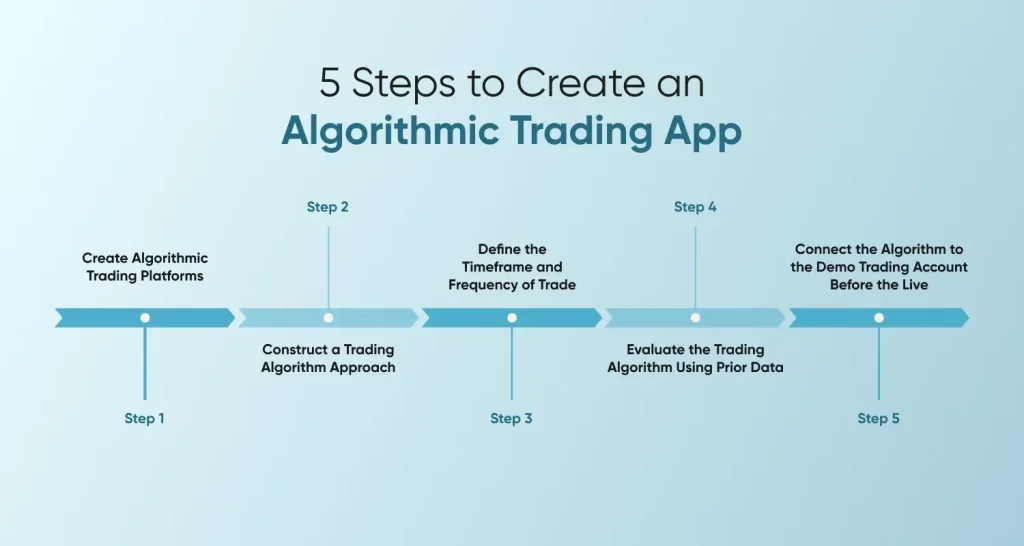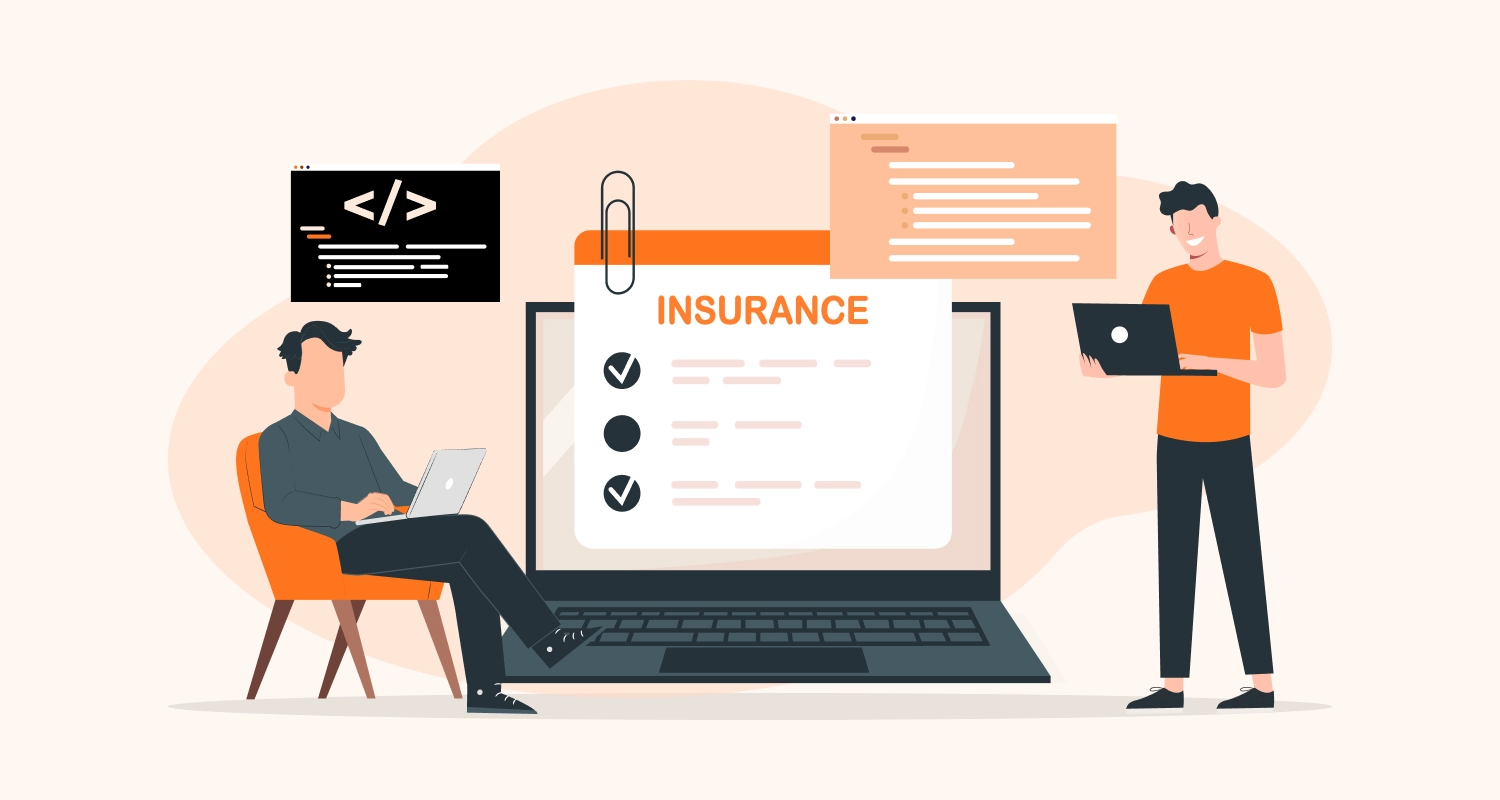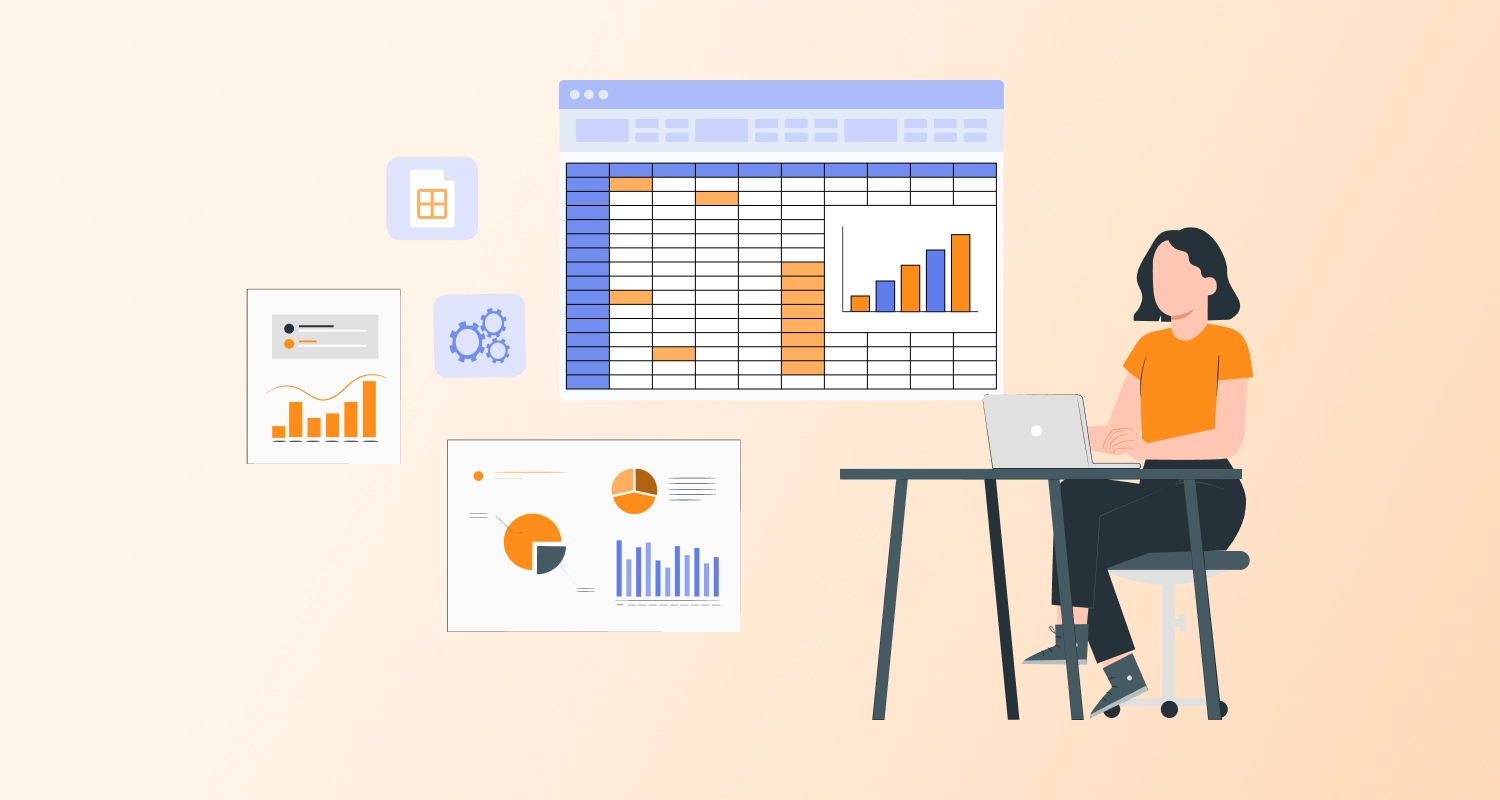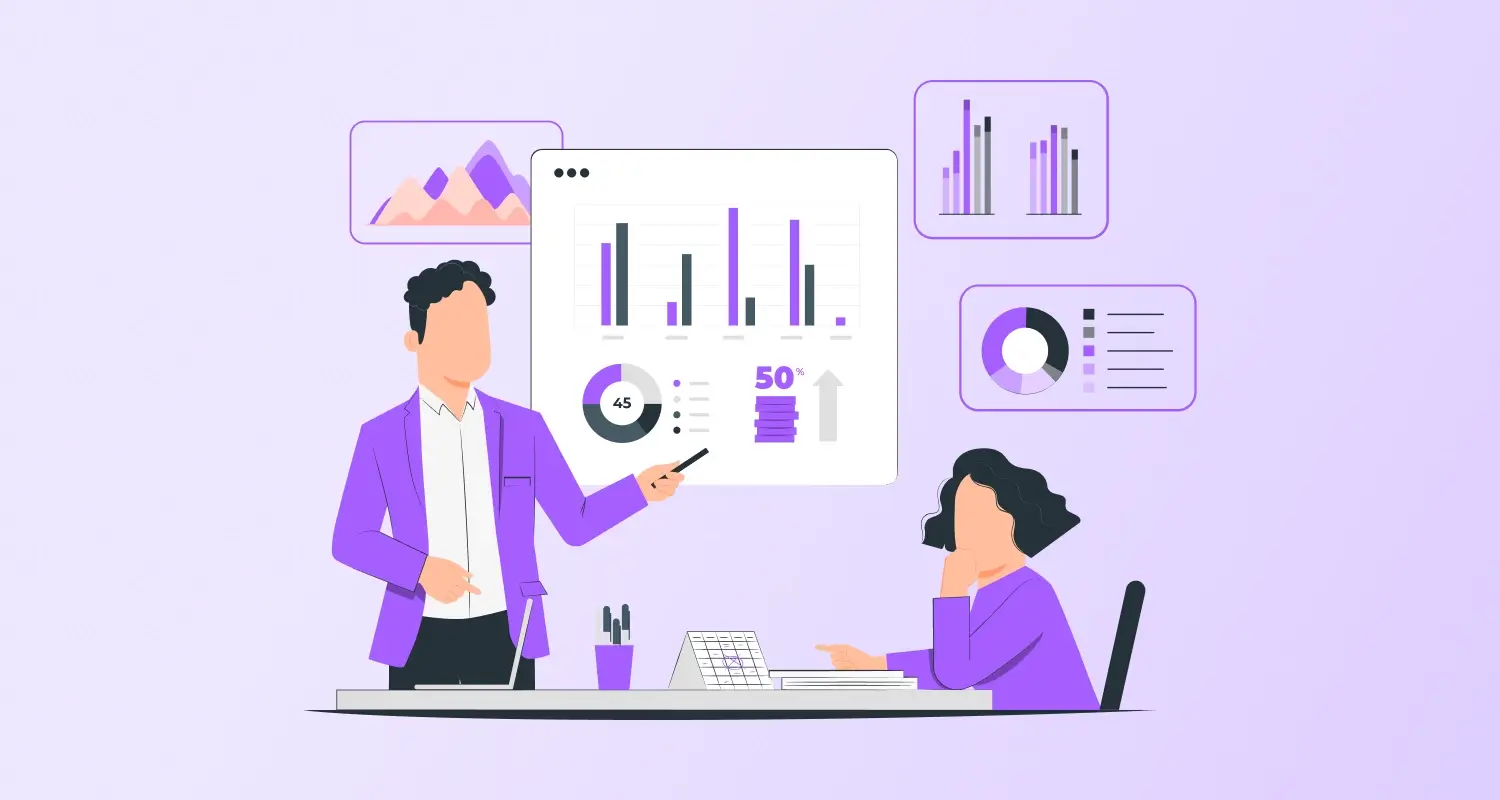Are you wondering how to build a trading bot of your own?
You have landed at the right place.
You will learn about the essential elements of algorithmic trading, as well as the primary complexities, benefits, drawbacks, and difficulties of developing trading algorithm software. After reading this article, you will also understand why you must choose a reputable finance software development company.
For any expert trader, developing and utilizing their algorithmic trading software would be the ideal growth strategy. Because it reduces mistakes and speeds up algorithmic trading, the software outperforms people in this domain.
The following tactics for automating trading procedures can be used with an app powered by AI and ML. It is on you to decide and approach to integrate in the program. However, once it is completed, leave it all to custom algorithm trading software.
What is Algorithm Trading and How Does it Benefit a Business?
A trading algorithm is a computer program that can create buy and sell orders in the financial markets by predetermined guidelines. Trading algorithms can execute a buy or sell order on your behalf if the current market conditions meet any predefined criteria. This helps in reducing the time to manual search of markets.
Automated trading software can lower the chance of human error, apply personalized methods, and boost the possibility of immediate order execution. Because of this, a lot of seasoned traders are searching for a seasoned trading platform development firm to create a platform that uses an automated trading technique.
Types of Algorithm Trading Software
On the trading platform, investors and traders can trade and keep an eye on stocks in real-time. This platform may take the shape of a mobile application, desktop application, or website.
Furthermore, there are primarily two kinds of trading platforms:
Commercial platforms are easy-to-use systems with trading newsfeeds, investor reports, and useful tools for traders and investors. Build a trading app like Robinhood Systems and Binance, these are the two best examples of such platforms.
Custom algorithm trading software development tailored to customers’ needs and particular trading techniques is known as a proprietary platform. Banks and other financial firms frequently employ proprietary platforms.
What are the Algorithm Trading Strategies?
Depending on the original instructions, trading software can be programmed to buy or sell automatically using a variety of strategies.
Arbitrage
Price margins are the reason this technique makes money. A dual-listed stock may be simultaneously sold at a greater price on one exchange after being purchased at a lower price on another. This is referred to as arbitrage or risk-free pricing differentials. Make substantial earnings risk-free using an algorithm that finds price differences and places orders accordingly.
Current Trends
The most popular algorithmic trading approach is to track patterns in moving averages. In addition, this technique keeps an eye on price levels and channel breakouts. The reason this tactic is the easiest is that it does not include predictions on price forecasts.
Index Fund Rebalancing
Rebalancing happens at specific intervals when it comes to index funds. Its goal is to level the playing field between index fund holdings and benchmark indexes.
Mathematical Model-Based Strategies
Mathematical models such as the delta-neutral method have been demonstrated to work. A range of locations with either positive or negative deltas make up the delta-neutral option.
Mean Reversion or Trading Range
The foundation of this stock algorithm is the idea that asset values periodically return to their average value and that price fluctuations are just momentary.
Volume-weighted Average Price (VWAP)
By leveraging stock-specific historical volume characteristics, the VWAP technique divides a large order into smaller ones before releasing it to the market.
Time Weighted Average Price (TWAP)
To release a large order to the market, the TWAP technique divides it into smaller ones utilizing equally spaced start and finish times. By positioning the order closer to the average price between the start and end hours on the market, the influence on the market is reduced.

Percentage of Volume (POV)
This algorithm takes into account the volume traded on the markets and delivers partial orders that are modified to the specified participation ratio. Orders are placed using the so-called “steps strategy” based on a user-defined percentage of market volumes.
Implementation Deficit
The total of the opportunity cost and execution cost incurred in the event of a negative market movement between the trading decision and order execution is known as the implementation deficit. The goal of employing this method is to minimize the implementation gap.
When stock prices move in a trader’s favor, this technique raises the desired participation rate; when they move to a trader’s disadvantage, it lowers it. Stated differently, it lessens the likelihood of a trader losing if the price moves during the decision-making process.
Additional Unusual Trading Algorithms
High-tech front-running algorithms are also involved. These algorithms identify other algorithms that a sell-side market maker uses on the opposite side. To avoid losing to traders who already employ algorithm tactics to spot big order possibilities, traders are therefore urged to use them.
5 Steps to Create an Algorithmic Trading App

Step 1: Create Algorithmic Trading Platforms
The purpose of building a platform is to store and retrieve data for backtesting from several data sources. Using historical data to test your algorithms can help you find the ideal set of buy and sell criteria.
There are two distinct methods:
Constructing your platform around an already-existing API.
Utilizing an already-existing platform, such as Python’s Backtrader. These systems are already linked to exchanges and built for backtesting.
This implies that you get to choose how to get started. You can obtain the capability of essential trading tools by using an existing platform. Nevertheless, you want to go with customized software development services if you want to maximize the returns on your trades. It makes provisions for unmatched flexibility of your data.
Step 2: Construct a Trading Algorithm Approach
Creating a plan is the most crucial component of an effective trading algorithm. But as you are aware, it is impossible to locate a winning method on Google. Research, mathematical reasoning, and a thorough grasp of financial markets are necessary for its production. Every market has unique regulations. Thus, methods designed for the stock market may not be the same as those that would be ideal for currency pairs.
Recall that if the technique cannot be represented in a flowchart, coding is not feasible. This implies that to create an automated trading system with implemented buy and sell orders and price goals based on measurable price data, you must establish a rule-based strategy.
Step 3: Define the Timeframe and Frequency of Trade
A critical metric for programming and data science is time frame. Thus, it should come as no surprise that multi-time frame comparisons and time frame analysis are essential elements of any profitable trading algorithm method.
While well-written trading algorithms operate on their own, it is always advisable to monitor and assess them. This means that when deciding on the time range and trading frequency, you should consider your availability. Long-term trading is a viable option for traders who lack the time to trade during the day, but other traders specialize in hft (high-frequency trading).
Step 4: Evaluate the Trading Algorithm Using Prior Data
It is advised to hold off on trading real money until the trading bot is tested when your trading algorithm is programmed using your approach. This entails applying the algorithm to previous pricing data. You may examine the algorithm’s performance over thousands of trades by utilizing various factors.
A comprehensive risk assessment should be produced using the historical testing phase’s data, which should be satisfactory. If yes, you can test the algorithm on a demo account under real-world situations without risk.
Step 5: Connect the Algorithm to the Demo Trading Account before the Live
It’s time to trade utilizing a live demo account, commonly known as paper trading, once the trading algorithm’s profitability has been verified. Since the market is impacted by the robot’s buy and sell orders, the actual market circumstances are different. Until it is confirmed that the trading algorithm program is operating in real-time, keep a close eye on things.
Technical Specifications for Developing Software for Algorithmic Trading
It’s time to put your selected algorithm technique into practice by employing a computer program. The program is then backtested to determine whether employing the algorithm would have been lucrative by comparing its results to the historical stock market behavior.
On the surface, this appears to be a way to turn the current algorithmic approach into a computer program that can place orders by accessing a trading account. The following are a few of the conditions for this procedure:
- Historical backtesting dataset;
- Infrastructure and ecosystem for algorithm backtesting before implementation on live markets;
- Understanding of computer programming, trading software, or hiring programmers to create an algorithmic trading strategy;
- Create an investment platform and build a network connectivity to enable order placement;
- Access to market data feeds to enable the algorithm’s comprehensive monitoring of the market.
Complex algorithms are constrained by both strictly functional and non-functional criteria in trading systems. The vast array of regulatory compliances that control algorithmic trading dictates it. It therefore necessitates a cautious approach to development, and the system architecture’s design and implementation should be given great thought.
Conclusion
Algorithmic trading methods can be implemented in a variety of ways thanks to new technologies and incredibly creative algorithm trading software. A human cannot possibly keep track of the thousands of little adjustments that take place every second.
However, taking these modifications into account and anticipating market swings can provide enormous profits. Trading algorithms reduce errors caused by human error, but they are intricate systems that must be created precisely to meet traders’ demands.
Hire dedicated developers to design and develop an algorithmic trading program. Though coding algo trading software is a difficult task, it takes the combined skills of professionals in programming and financial markets knowledge. A software development team with skilled members who are proficient in Python or C++ may successfully design your algorithmic trading system after you have a rules-based strategy in place.
Create your bespoke trading software right now, without delay.
Frequently Asked Questions
What Is Algorithmic Trading Software?
The technique of employing computers designed to execute a predetermined set of instructions for placing a trade to make profits at a pace and frequency that is unfeasible for a human trader is known as algorithmic trading, also known as automated trading, black-box trading, or simply algo-trading.
How to Create a Trading Algorithm?
Step 1: Establish a platform.
Step 2: Visualize and discuss the trading strategy.
Step 3: Decide on a time frame.
Step 4: Algorithm Strategies Testing.
Step 5: Link the live demo algorithm.
What Are the Main Challenges in Algorithmic Trading?
Algorithmic trading has several obstacles, including creating lucrative systems, handling moral and legal issues, integrating new technologies, and comprehending the microstructure of the market.
How Much Does It Cost to Develop an Automated Trading System?
Depending on the intricacy of the software, the mobile app development company in India charges between $70,000 and $2,35,000 USD to construct a solid algorithmic trading platform.







